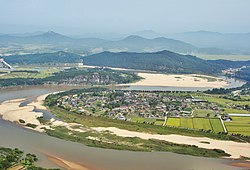Andong
|
Andong 안동시 |
||
|---|---|---|
| Municipal City | ||
| Korean transcription(s) | ||
| • Hangul | ||
| • Hanja | ||
| • Revised Romanization | Andong-si | |
| • McCune-Reischauer | Andong-si | |

An aerial view of Hahoe Folk Village
|
||
|
||
 Location in South Korea |
||
| Coordinates: 36°33′33″N 128°43′44″E / 36.55917°N 128.72889°E | ||
| Country |
|
|
| Region | Yeongnam | |
| First mention | 930 | |
| City status | 1963 | |
| Administrative divisions | 1 eup, 13 myeon, 10 dong | |
| Area | ||
| • Total | 1,590.91 km2 (614.25 sq mi) | |
| Elevation | 139 m (456 ft) | |
| Population (2012) | ||
| • Total | 167,942 | |
| • Density | 110/km2 (270/sq mi) | |
| • Dialect | Gyeongsang | |
| Postal code | 760003-760944 | |
| Area code(s) | (+82) 054 | |
| Website | Official website | |
Andong is a city in South Korea, and the capital of North Gyeongsang Province. It is the largest city in the northern part of the province with a population of 167,821 as of October 2010. The Nakdong River flows through the city. Andong is a market centre for the surrounding agricultural areas.
Since the 1970s Andong has developed rapidly, although the population has fallen by nearly seventy thousand as people have moved away to Seoul and other urban centers. In the late 1990s and early 2000s it became a tourism and cultural centre.
Andong is known as a centre of culture and folk traditions. The surrounding area maintains many ancient traditions, so in mid October the Andong Folk Festival is held every year. One of the most famous aspects of these cultural festivities are the Andong masks.
Andong National University, specialising in education and Korean folklore, has grown rapidly since the 1970s. Other tertiary institutions include Andong Science College and Catholic Sangji College.
Around 1 BC, Andong was founded by the Jinhan people, and it was known as Gochang. During the Three Kingdoms period, the area was controlled by the Silla kingdom. The Battle of Gochang in 930 was fought here between Hubaekje forces and the Goryeo army led by Wanggeon, who won control of the city and renamed it Andong.
After the ascent of the Joseon dynasty to the throne of Korea, Andong became a centre of Confucianism. The area was extremely conservative for a long time and produced many leading confucian scholars. Toe-gye Yi Hwang (1501–70), one of the most prominent of all Korean scholars, came from Andong. Yi Hwang retired back to his homeland late in life and started the establishment of the great Confucian academy Dosan Seowon there, which was finished after his death. During this period Andong and its principal families were influential within Korean political circles, of which the three notable families were the Andong Kim, Andong Jang and Andong Kwon clans.
...
Wikipedia

